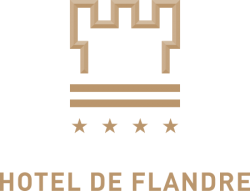Hotel de Flandre, a place full of history!
Hotel de Flandre, located in the heart of Ghent, consists of two historic carriage houses, each with five floors. These buildings date back to the early 19th century and, as far as we know, have served as a hotel since their construction. Many authentic features from that time have been preserved, giving the hotel its unique charm.
The entrance hall is a beautiful example of the building’s historical character. In the 1800s, it served as a passage for merchants arriving by horse and carriage. The rooms on the ground floor overlooking the courtyard were originally used as stables.
Another notable feature is the neoclassical façade, which has been carefully restored. The elegant front, with its eight bays and four and a half stories, is topped with a decorated frieze. The entrance is marked by a grand arched gate that still welcomes guests today.
Throughout its rich history, the hotel has hosted many notable guests. For instance, the Austrian composer Joseph Strauss stayed in the suite during a visit to Ghent in 1838 for performances of his music. Other distinguished guests included French writers Chateaubriand and Lamartine, as well as members of King Louis XVIII’s entourage, such as Baron Louis, Count de Beugnot, and Bertin de Vaux, director of the Journal Universel. They stayed at the hotel during the "Hundred Days" when the French king fled Napoleon’s return from Elba.
Today, the modern Hotel de Flandre still stands at Poel 1–2, on the same site as the original "Hôtel de Flandre", offering contemporary comfort with a deep sense of history.
A little anecdote to end with...
After the first train arrived in Ghent in 1837, a horse-drawn omnibus service was introduced at the South Station to transport passengers to the city’s hotels. Competition between the operators was fierce, with each trying to attract as many travelers as possible. Of the original fifteen omnibuses, only five remained after one year. Ten years later, just two were still running—one for Hôtel de Flandre and one for Hôtel de Courtrai, both located near Poel and Drabstraat. A few years after that, these carriages also disappeared from the streets of Ghent.
